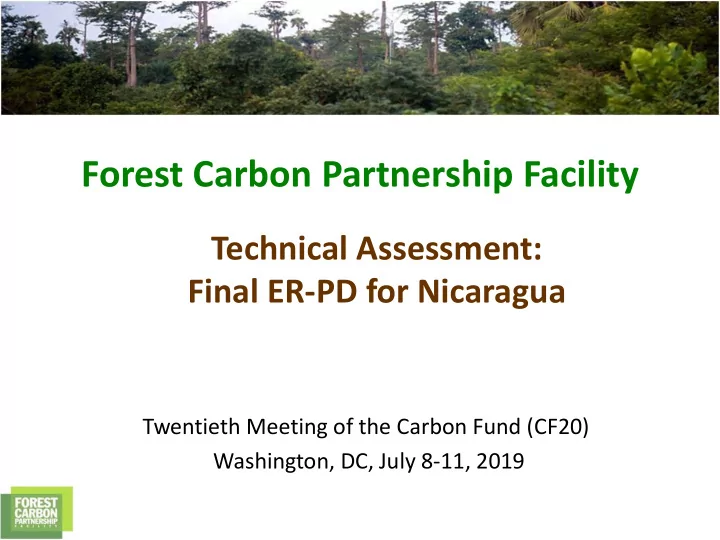

Forest Carbon Partnership Facility Technical Assessment: Final ER-PD for Nicaragua Twentieth Meeting of the Carbon Fund (CF20) Washington, DC, July 8-11, 2019
Presentation of TAP ▪ The technical assessment was conducted from Nov 6, 2017 to May 21, 2019, by the following team: Person TAP expertise Ben de Jong Leader, Carbon accounting Agustin Inthamoussu Carbon accounting expert Claudio Cabrera Gaillard Local expert Mario Nanclares Safeguards expert Joshua Lichtenstein Safeguards expert Moritz von Unger Legal expert 2
Overall assessment of final ER-PD Initial Review 1 st assessment 2 nd assessment YES 3 3 3 II. Level of Ambition NO 0 0 0 N.A. 0 0 0 YES 18 24 33 III. Carbon Accounting NO 15 9 0 N.A. 10 10 10 YES 4 6 6 IV. Safeguards NO 2 0 0 N.A. 1 1 1 YES 9 9 9 V. Sustainable Program NO 0 0 0 Design and Implementation N.A. 4 4 4 YES 5 6 8 VI. ER Program Transactions NO 3 2 0 N.A. 3 3 3 3
II. Level of Ambition Ind. 2.1 The Accounting Area is of significant scale and aligns with one or more jurisdictions; or a national-government-designated area (e.g., YES ecoregion) or areas. ▪ The ER Program incorporates all six strategic pillars, as well as various of the 37 strategic actions of the national REDD+ Strategy. ▪ It focuses on the geographical area with the highest priority for reducing forest-based greenhouse gas emissions in Nicaragua. ▪ The accounting area is of significant scale and comprise about 80% of the forests, the majority of the indigenous populations and all indigenous and afro-descendant autonomous territories. 4
III. Carbon Accounting 5.1 The ER Program identifies the IPCC methods used to estimate emissions and removals. 8.2 Random errors and other uncertainties are minimized YES 9.1 Uncertainty associated with activity data and emission factors is quantified using accepted international standards ▪ OBSERVATION 5.1 : The country should consider the construction of national allometric equations in order to reduce the uncertainty of the generic equation. ▪ OBSERVATION 8.2 : The elaboration of SOPs and QA/QC procedures are standard requirements for MRV. The country should convert the applied procedures described in the ERPD to SOPs and QA/QC procedures. ▪ OBSERVATION 9.1 : In line with the guidance on uncertainty analysis provided in the Methodological Framework, the country should use the 5% and 95% quantiles of the resulting distribution of the 10,000 MC simulations as the basis to estimate the uncertainty of the reference level. This approach would guarantee with 90% probability that the reference level falls within the estimated limits and avoid an underestimation of uncertainty. This same approach should be used for Emission Reductions estimation. 5
III. Carbon Accounting 11.2 The start-date for the Reference Period is about 10 years before the end-date. 14.2 Activity data are determined periodically, at least twice during the Term of the ERPA YES 18.1 The ER Program has undertaken an assessment of the anthropogenic and natural risk of reversals ▪ OBSERVATION 11.2 : The country should clearly indicate the month and the year of the start and end dates of the reference period and reporting periods to ensure that the number of years are correctly accounted. ▪ OBSERVATION 14.2 : The country should clarify in the procedures for monitoring that the spatial buffer that is used to separate anthropogenic and natural degradation should be monitored as this may change over time due to new infrastructure in the accounting area. ▪ OBSERVATION 18.1 : The country should prepare a plan for implementation of all the listed improvements to be made beyond the term of the ERPA, including the institutions in charge of implementation, the source of the budget, the timeline, etc. 6
III. Carbon Accounting C 23 To prevent double-counting, ERs generated under the ER Program shall not be counted or compensated for more than once. YES (i) Participation under other GHG initiatives 18.1 • OBSERVATION 23 i : The country should investigate if there are any legal restrictions to negotiate other REDD+ initiatives within the accounting area as this may be considered as a guarantee that this exclusive condition will remain so in the future. 7
V. Sustainable Program Design and Implementation 28.1 The ER Program reviews the assessment of land and resource tenure regimes carried out during the readiness phase at the national YES level • OBSERVATION 28.1 : It is recommended that such legal roadmap also should address land disputes with “third parties” and viable solutions including in terms of offering livelihood perspectives for migrant families concerned. 8
V. Sustainable Program Design and Implementation 34.2 Stakeholder engagement processes carried out for the ER Program design and for the readiness phase inform the identification of such priority Non-Carbon Benefits YES 35.1 The ER Program proposes an approach utilizing methods available at the time to collect and provide information on priority Non-Carbon Benefits • OBSERVATION 34.2: The Country is recommended to further consult the stakeholders as part of the Consultation and Participation Process, in order to obtain more information about the prioritized Non-Carbon Benefits. • OBSERVATION 35.1: The Country is recommended to indicate how the information of non-carbon benefits will be delivered to the different actors involved in the Program implementation 9
Concluding remarks ▪ The Nicaraguan government has done an excellent effort to develop a solid and interesting ER-PD. ▪ The proposal is of special interest as it intends to develop a regional program that implies dealing with a complex governmental structure that include the central government and various regional authorities from the autonomous regions. This implies that a decision making institution has to be in place that can cope with this organizational complexity. We congratulate the Nicaraguan government for developing this very interesting endeavor! ▪ The ER-PD meets the criteria and indicators of the methodological framework, but the TAP identified some opportunities for improvement that can should be addressed before signature of the ERPA or first verification. 10
Thank You! Nicaragua 11
Recommend
More recommend